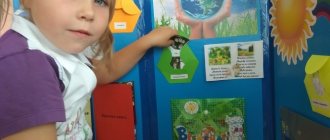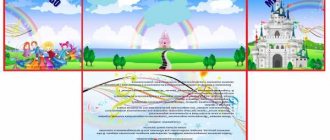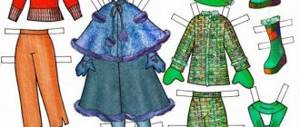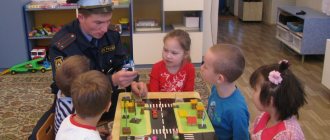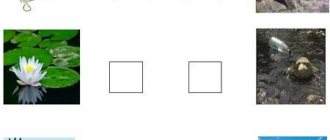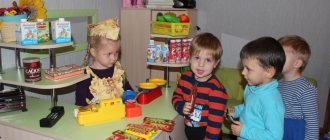What is a traffic rules lapbook for preschoolers
The concept of lapbook is made up of two English words: lap (lap) + book (book). Such an interactive educational book is needed to collect and organize information on any topic. Each lapbook is individual. Its structure can be arbitrary, depending on the wishes of the child and his level of knowledge on the topic.
The main advantages of such a book for a child:
- Attractive appearance that arouses interest and is an incentive to study the content.
- A large amount of information presented in a concise form that is easy to learn and remember.
Typewriter folder created by preschool students
The traffic rules lapbook for kindergarten is designed to familiarize pupils of different age groups with traffic rules, signs and symbols on the road, illustrate examples of dangerous and safe behavior near the roadway, help the child learn these rules and not get confused on the spot. In a kindergarten, a lapbook can be made in the form of a common stand or folder for each child.
Lapbook “Road Rules”
Lapbook “Road Rules”
In connection with the implementation of the Federal State Educational Standard for preschool education, every teacher is looking for new approaches and ideas in their teaching activities. I began to study and use in my work a completely new, interesting, irreplaceable teaching aid - a lapbook. It can be used both in kindergarten and at home. A laptop is interesting and useful because it is made jointly by an adult and children.
Lapbook – literally translated from English means “knee book” (lap – knees, book – book). This is a small homemade folder that a child can conveniently lay out on his lap and view all its contents at one time. But, despite its apparent simplicity, it contains all the necessary
Lapbook on traffic rules in preschool educational institutions: production
The basis of the reference lapbook is created by the teacher, and the structure and individual elements are created by the child together with parents, teachers from the kindergarten and other children. With the help of a colorful lapbook, a child can easily understand, structure and remember important definitions and rules, and learn previously learned material. The basis of a lapbook can be a cardboard folder for storing documents or a folded sheet of cardboard.
Elements of the internal content of the manual can be printed in the form of templates or made independently. The inside of the folder in the form of 2-3 sheets of A3 or A4 format is covered with colored paper or scrapbooking paper. Pockets, mini-books, notebooks, etc. are glued in any form. It is advisable to place important traffic rules in a separate envelope, and fill other elements of the folder with riddles, puzzles, poems and games.
Additional Information! The cover and title page of the laptop can be decorated with a thematic picture or drawing, or 3D applique. Inside the folder you can stick decorative elements in the form of figures made of felt or paper.
Content
During the creation and filling of a lapbook, the child demonstrates his creative abilities, aesthetic taste, applies theoretical skills acquired in class, groups materials according to certain characteristics, and better understands and remembers information.
Didactic manual with various elements
A lapbook on traffic rules in a preschool educational institution may contain the following:
- cards;
- envelopes (standard, curly) and pockets;
- houses with opening shutters;
- photographs and drawings;
- diagrams and tables;
- small books (with pages and accordions);
- moving elements (rotating circles).
Examples of lapbooks on traffic rules
Before starting to work on a lapbook, you need to outline what the child should learn and master in the process of studying with the book, which elements to place, in what sequence.
For example:
- Rules of conduct for a preschooler on the road and near the roadway;
- road signs and indicators;
- types of vehicles;
- familiarization with the traffic controller's uniform and his tools;
- poems dedicated to traffic rules;
- traffic rules quiz;
- thematic riddles.
Federal State Educational Standard for Preschool Education
Note! Rules of behavior on the road can be presented in poetic form, easy and exciting for a child.
Draw vehicles on the cards. The child must distribute them into pockets, each containing a specific type of transport (special equipment, land, railway, air, water). The goal is to develop classification skills and introduce new concepts.
To get acquainted with road signs and pointers, the child can be asked to color their images, solve riddles and puzzles. Print the text of the riddle on each card. Also prepare cards with images - answers. Distribute all materials into envelopes. The teacher reads the text of the riddle, and if the child answers correctly, shows a picture.
This activity contributes to the following:
- memory training;
- development of intelligence;
- mastering traffic rules in a playful way.
On one of the sheets you can place a colorful image of a traffic controller with a description of the elements of his uniform and tools (rod and whistle), and give a poem about a representative of this profession. The quiz can be about traffic rules, traffic signals, road signs or markings.
Example of a colorful leaflet
Materials
To make a training knee book you will need the most accessible materials:
- A3 or A4 folder;
- cardboard;
- scrapbooking paper;
- white and colored paper;
- felt;
- paper glue;
- scotch;
- markers;
- watercolor paints and felt-tip pens;
- stapler;
- safety scissors.
Important! During the work, the child must use materials and tools under the supervision of an adult.
Creative materials
Methodological guide for preschool children: Lapbook “Learning the rules of the road”
Municipal autonomous preschool educational institution of the municipal formation of the city of Krasnodar
"Child Development Center - Kindergarten No. 180 "Treasure Island"
Methodological manual for preschool children:
Lapbook “Learning the rules of the road”
Educator:
Barykinskaya Elvira Vladimirovna
Krasnodar, 2020
Didactic manual on traffic rules for children of primary and secondary preschool age: Lapbook “Road Rules”
The laptop is a new teaching tool that meets the new requirements and goals of training and education in the context of the implementation of the Federal State Educational Standard.
Lapbook
-literally translated from English it means “knee book” (lap-knees, book-book). It collects material on a specific topic. Americans were the first to create lapbooks. A laptop looks like an interactive book, the information in which is presented in the form of windows that open, leaves that come out and unfold, and other funny details. On the one hand, they are designed to attract the child’s interest in the folder itself. On the other hand, this is a great way to present all available information in a compact form. Creating a lapbook is one of the types of joint interactive activities between adults and children. In the future, the child will learn to independently collect and organize information - good preparation for research activities.
Why did I decide to use a lapbook in my work with children?
Relevance.
In connection with the implementation of the Federal State Educational Standard for preschool education, every teacher is looking for new approaches and methods of work in their teaching activities. So I decided to use a completely new methodological guide in my work - a lapbook.
A laptop looks like an interactive book, the information in which is presented in the form of pockets. Bright pictures that attract children's interest to the folder itself. On the other hand, this is a great way to present all available information in a compact form. The laptop has a rectangular shape. Its content can change and be supplemented with new information as children master the proposed material. The “Traffic Pavila” lapbook I made helps consolidate and systematize previously covered material, and also helps children work independently.
Material for the lapbook and travel folder was selected for all educational areas: speech development (riddles, poems, proverbs, pictures with various situations on the roads for children to answer, what they would do in this situation); cognitive development (puzzles, didactic games: “Traffic light”, “Repair the traffic light?”, puzzles); artistic and aesthetic development (coloring); social and communicative development (crosswords with names of road signs).
Description of lapbooks
The content of the knee books depends on the age and level of training of the student.
For middle groups 4-5 years old
The purpose of the traffic rules lapbook for middle groups of preschool educational institutions is to introduce preschoolers to the rules of the road for pedestrians and drivers, the components of the road, road signs and indicators for all road users.
Important! The manual is designed to arouse the child’s interest in the topic and introduce important rules in a familiar playful way.
In the process of working with a lapbook, the child will train and develop speech, memory, and communication with other team members.
The folder may contain the following sections:
- cards with traffic rules;
- types of transport in pictures;
- poems about traffic rules;
- simple riddles (texts + pictures);
- labyrinths (to build a safe path from home to preschool educational institution);
- coloring cards (road sign, vehicle);
- thematic puzzles from several parts;
- games with elements of physical activity.
It is better to place cards with traffic rules in a pocket, in the central part of the book. The purpose of this section is to consolidate a young child’s knowledge of traffic rules, convey information about the need to be vigilant and careful near a highway, not to get lost and clearly know how and where to cross the roadway. The purpose of riddles on the topic is to develop intelligence, the ability to correlate a text description and an image of an object, and enrich speech.
The essence of the game “labyrinths” is to create a safe route from point A to point B using chips or fingers with the child’s comments. The goal is to develop intelligence, logic, attention, fine motor skills, and speech.
How to quickly teach children to tie their shoelaces with a bow
Note! To make the lesson more effective, you should change the type of activity.
For example, you can arrange a game between two teams: drivers and pedestrians. The teacher or student takes a blank from the envelope - traffic signals and shows one of the images. Depending on the color, the participants in the game walk or stand still. The goal is to develop memory, reaction speed, and coordination of movements.
For older groups 5-6 years old
Note! The goals of creating a kneeling book for children 5-6 years old are to systematize knowledge on the topic, convey the importance of traffic signals, teach how to classify road signs, develop attention, independence, and caution.
Envelopes with tasks and games in accordance with the age of preschool children:
- meaning of traffic lights;
- road signs and their meaning;
- types of transport (classify, find the odd one out);
- puzzles;
- coloring books (consolidating knowledge on the topic, developing fine motor skills, accuracy);
- poems on the topic of traffic rules;
- puzzles and crosswords;
- questions (to determine the correctness/incorrectness of actions on the road);
- puzzles;
- game “situations on the road” (the teacher voices the situation, and the children act it out on a model of the road using toy men or animals);
- left-right (arrange vehicle printouts according to the direction of travel);
- find differences (up to 10 positions);
- outdoor game (children perform certain actions at the traffic light signal);
- visual information (selection of educational videos and cartoons on the topic of traffic rules).
For preparatory groups 6-7 years old
Pupils of preparatory groups can not only improve their knowledge in the field of traffic rules, but also actively participate in the collection and systematization of information.
The purpose of creating a thematic folder is to consolidate acquired knowledge, awareness of the importance of safe behavior on and near the road, readiness to cross the roadway at both regulated and unregulated crossings, teach how to prevent dangerous situations and clearly act when necessary. You can include all of the above elements in the manual, complicating them and diversifying the content.
Important! Thanks to the attractive appearance and thoughtful structure of the lapbook, children can easily and in a relaxed manner expand their knowledge base.
Folder for older children
Lapbook on traffic rules for the senior group of preschool educational institutions
- July 2, 2016
Competition “Lapbook as a learning tool in the conditions of the Federal State Educational Standard”
Nomination “Use of a laptop in the pedagogical activities of a preschool teacher”
I present to your attention a lapbook made for the senior group on the topic of traffic rules. The safety of children on the road primarily depends on adults. It is not enough to simply tell that the traffic light has three colors, and you only need to cross the road when the signal is green. The most important thing is a personal example and the presence of knowledge and experience.
Most often, traffic rules are very difficult to instill in children, because they do not captivate the child, they are not interesting to him. Therefore, I offer you a didactic manual for teaching children the Rules of the Road!
Relevance: due to statistics on the growth of child injuries on the roads.
Thematic folder in A4 format is a didactic aid for strengthening children's knowledge about traffic rules. On the pages of the folder there are pockets that contain information on this topic, taking into account the interests of children. This didactic manual is a developmental teaching tool and contains material for organizing collective creative activities, communicative development of children, and gaming technologies.
Lapbook goals:
- To form a system of knowledge, skills and abilities of children according to traffic rules.
- To consolidate knowledge about traffic lights and signals, road signs, and the rules for crossing the roadway.
- Develop observation, attentiveness, thinking.
Lapbook tasks:
Educational: Introduce children to the rules of the road, rules for crossing the roadway, road signs intended for drivers and pedestrians; teach children to anticipate a dangerous event, be able to avoid it if possible, and act if necessary.
Developmental: Develop caution, attentiveness, independence, responsibility and prudence on the road; stimulate cognitive activity, promote the development of communication skills.
Speech: Develop children's coherent speech, expand and activate children's active and passive vocabulary.
Educational: To develop personal safety skills, a sense of self-preservation, and a sense of responsibility.
Lapbook contents
The lapbook contains materials about traffic rules for educational activities with children of senior preschool age. It includes 8 developmental tasks:
1. Pocket “Soobrazhalka” (quizzes on traffic rules, constantly updated).
2. “Guess the sign” pocket.
3. “Name the transport” pocket.
4. Pocket “Rebuses” (constantly updated).
5. Pocket “Road Signs” (puzzles are constantly updated).
6. Pocket “Road Rules Coloring Book”.
7. Pocket “Riddles on traffic rules” (constantly updated).
8. Pocket “Traffic Light Town” (assemble a paper town: road, houses, transport, pedestrians, road signs).
Author: Elena Viktorovna Zaitseva, teacher of the Vasilyevsky Children's Preschool Educational Institution, Shuisky district, Ivanovo region, Vasilievskoye village. Work experience in preschool educational institutions for 4 years, total pedagogical experience 20 years.
